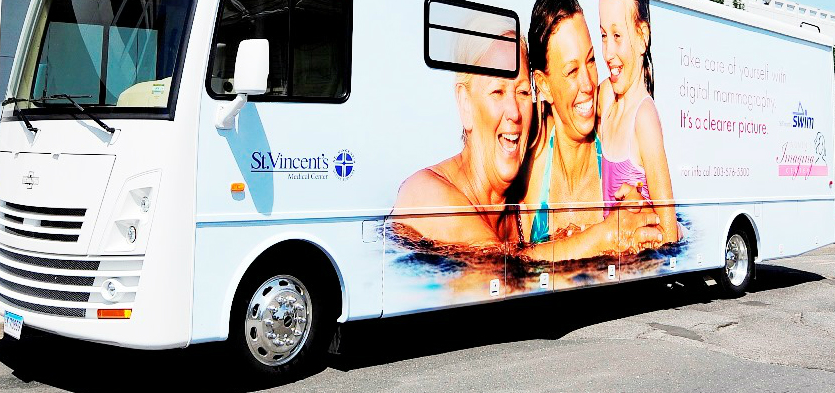
The St. Vincent Indianapolis Mobile Screening Program is pleased to partner with BUTLER UNIVERSITY to offer you on-site screening mammograms on the following dates & times:
MONDAY NOVEMBER 4 & TUESDAY NOVEMBER 5 from 8 am – 2 pm
We now offer Digital Tomosynthesis or 3-D mammograms on the mobile unit as part of our standard of care. Digital Tomosynthesis is an advanced form of mammography that creates a 3-dimensional picture or a high resolution mammographic image of your breast tissue. Most health insurance providers cover all costs associated with 3D mammograms. Please consult with your health insurance provider to determine if the cost for the 3D – Digital Tomosynthesis is fully covered. You may request a 2D-mammogram if the costs are not covered by your health insurance provider.
Participation Information:
- Please review this information letter (below) and the screening guidelines to determine if you are eligible to participate.
- If you are eligible, please call the St. Vincent Breast Center at (317) 338-9595 to schedule your appointment. When calling, please inform the operator that you are calling from BUTLER UNIVERSITY to schedule an appointment on the mobile unit on the specified date and time.
- Registration deadline is one week prior to our scheduled visit.
Appointment Information:
- Screening appointments typically last for 20 minutes. It’s important for you to be on time for your appointment. If you are 10 or more minutes late, your appointment will be cancelled.
- You must bring your health insurance card(s) and driver’s license or photo ID with you to your mammogram appointment. If your health insurance information is electronic, please bring a paper copy of your information with you to your appointment.
- Please wear a two-piece outfit.
- If you are wearing deodorant at the time of your appointment, you will be asked to wipe it off. Deodorant distorts the images/x-rays. Fresh deodorant will be provided.
St. Vincent is one of the pioneers when it comes to breast health. Each year more than 4,000 women receive their screening mammograms through the mobile mammography unit. We believe that early detection saves lives and is the strongest weapon in fighting cancer. Thank you for the opportunity to serve you!
Sincerely,
Karen Terrell
Community Outreach & Education Coordinator
MOBILE MAMMOGRAPHY SCREENING GUIDELINES
You are eligible for a screening mammogram if:
- You are a woman age 40 or older;
- You are a woman age 31-39 with a family history of breast cancer and a referral from a physician;
- You have a current primary care physician;
- If you do not have a primary care physician, there is a process in place to provide you with a primary care physician
- Your last mammogram was performed at least 11 months + 1 day ago
- You must be asymptomatic for breast diseases.
You are NOT eligible for a screening mammogram if:
- You are not asymptomatic (please see below for more details);
- You are pregnant;
- You are a nursing mother (breastfeeding must have stopped completely at least 3 months prior);
- You have had follow-up recommendations after a previous mammogram, but never completed the follow-up recommendations;
- You have had your last screening mammogram less than 11 months ago;
- You are between the ages of 31-39 with no history of breast cancer in your immediate family & no doctor’s referral/order;
- You are age 30 or younger;
- You have had a mastectomy or lumpectomy for breast cancer and are less than five years from the original diagnosis.
Additional Information:
Many health insurance providers or employers will cover the costs for mammograms annually; however, you must meet all screening guidelines to be eligible. This includes the length of time in between mammogram screenings (i.e. 11 months + 1 day). Screening mammograms are intended for women without symptoms of breast disease. If you have any of the following symptoms, you are NOT ELIGIBLE for a screening mammogram and should follow-up with your primary are physician immediately:
- Lump (or thickening) in a breast (with or without implants) or the underarm area;
- Dimpling or puckering of the skin anywhere on the breast;
- Change in color (redness) or texture of the skin on the breast;
- Retraction (sinking in) of the nipple;
- Discharge or bleeding from the nipple;
- Increase in size of one breast; change in shape or contour of the breast;
- Changes in or around the nipple (i.e. dry, itchy or flaky skin or sores on the breast);
- Swelling in the breast or upper arm area.
